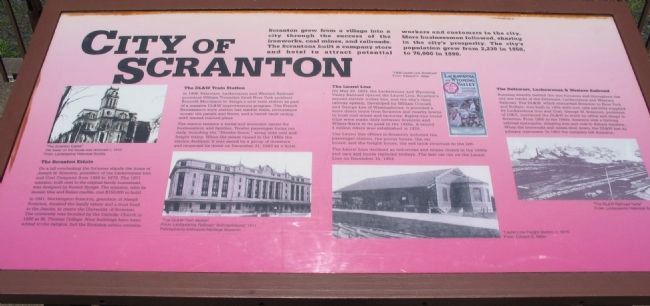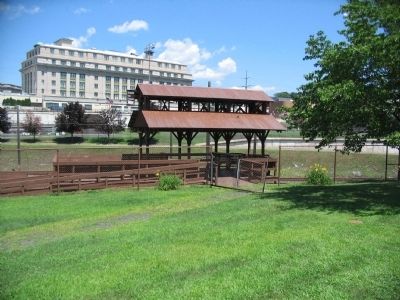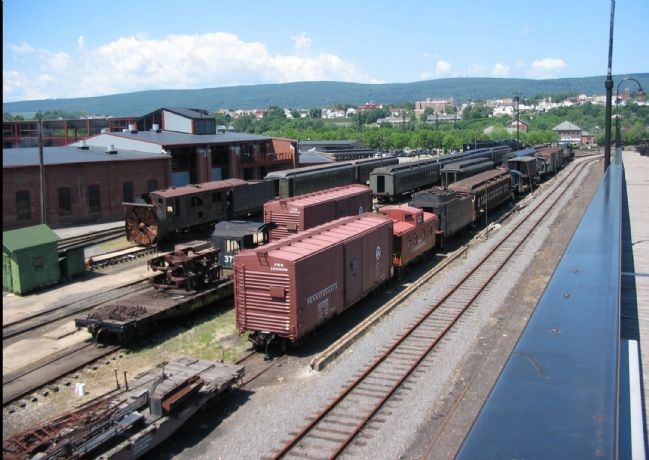Scranton in Lackawanna County, Pennsylvania — The American Northeast (Mid-Atlantic)
City of Scranton
The Scranton Estate
On a hill overlooking the furnaces stands the home of Joseph H. Scranton, president of the Lackawanna Iron and Coal Company from 1858 to 1872. The 1871 mansion, built next to the original family homestead, was designed by Russell Sturgis. The mansion, with the mosaic tiles and Italian marble, cost $150,000 to build.
In 1941, Worthington Scranton, grandson of Joseph Scranton, donated the family estate and a trust fund to the Jesuits, to create the University of Scranton. The university was founded by the Catholic Church in 1888 as St. Thomas College. New buildings have been added to the campus, but the Scranton estate remains.
The DL&W train Station
In 1908, Delaware, Lackawanna and Western Railroad president William Truesdale hired New York architect Kenneth Murchison to design a new train station as part of a massive DL&W improvements program. The French Renaissance style station has marble walls, picturesque mosaic tile panels and floors, and a barrel vault ceiling with leaded stained glass.
The station became a social and economic center for businessmen and families. Twelve passenger trains ran daily, including the "Phoebe Snow," along with coal and freight trains. When the mines closed in the 1940's the station declined, it was saved by a group of investors and reopened its doors on December 31, 1983 as a hotel.
The Laurel Line
On May 20, 1903, the Lackawanna and Wyoming Valley Railroad opened the Laurel Line, Scranton's second electric trolley line, and the city's third railway system. Developed by William Connell and George Lee of Westinghouse, it provided a more direct route from Scranton and nearby towns to local coal mines and factories. Eighty-one round trips were made daily between Scranton and Wilkes-Barre at its peak in the 1920s. A record 4 million riders was established in 1920.
The Laurel line offices in Scranton included the passenger station, the power house, the car house, and the freight house, the red brick structure to the left.
The Laurel Line declined as industries and mines closed in the 1940s and cars and buses replaced trolleys. The last car ran on the Laurel Line on December 31, 1952.
The Delaware, Lackawanna & Western Railroad
Running directly behind the iron furnace and throughout the city are tracks of the Delaware, Lackawanna, and Western Railroad. The DL&W, which connected Scranton to New York and Buffalo, was built in 1855 with iron rails partially supplied by Lackawanna Iron and Coal. George W. Scranton, president of the LI&C, convinced the DL&W to build its office and shops in Scranton. From 1850 to the 1940s, Scranton was a thriving railroad metropolis, shipping iron and coal to distant markets. When the ironworks and mines shut down, the DL&W lost its primary customers. In 1951 the company left Scranton.
Topics. This historical marker is listed in these topic lists: Industry & Commerce • Railroads & Streetcars. A significant historical month for this entry is May 1880.
Location. 41° 24.245′ N, 75° 39.745′ W. Marker is in Scranton, Pennsylvania, in Lackawanna County. Marker can be reached from the intersection of Cedar Avenue and Mattes Avenue, on the right when traveling north. Located at the Scranton's Iron Furnace Park. Touch for map. Marker is in this post office area: Scranton PA 18505, United States of America. Touch for directions.
Other nearby markers. At least 8 other markers are within walking distance of this marker. The Lackawanna Valley (a few steps from this marker); Settlement (a few steps from this marker); Making Steel (within shouting distance of this marker); Rolling and Puddling (within shouting distance of this marker); Casting Iron (within shouting distance of this marker); Supplying the Blast (within shouting
distance of this marker); Scranton Iron Furnaces (within shouting distance of this marker); The Blast Furnaces (about 400 feet away, measured in a direct line). Touch for a list and map of all markers in Scranton.
More about this marker. Above each section are photos of the buildings referenced in the text. In the upper left is a photo of the Scranton Estate. The tower on the house was removed c 1910. In the lower center is a photo of the DL&W train station. Next to that is a photo of the Laurel Line Freight Station. To the right is a photo of the DL&W railyards.
Credits. This page was last revised on June 16, 2016. It was originally submitted on August 21, 2008, by Craig Swain of Leesburg, Virginia. This page has been viewed 1,667 times since then and 34 times this year. Photos: 1, 2, 3. submitted on August 21, 2008, by Craig Swain of Leesburg, Virginia.


